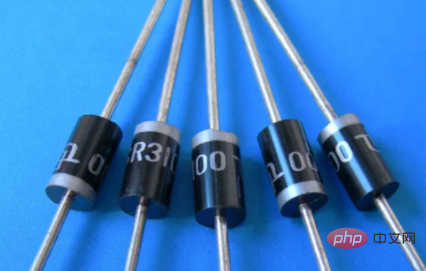
SR2100 diode can be replaced with SR5200; SR2100 is a fast recovery diode, a Schottky diode, with a maximum current of 2A and a maximum reverse withstand voltage of 100V; and SR5200 is also a Schottky diode, with a maximum current of 5A. The maximum reverse withstand voltage is 200v; the parameters of SR5200 are higher than SR2100, so there is no problem in replacement.

#The operating environment of this tutorial: Windows 10 system, Dell G3 computer.
What can I use to replace the sr2100 diode?
SR2100 diode can be replaced with SR5200.
SR2100 is a fast recovery diode, a Schottky diode, with a maximum current of 2A and a maximum reverse withstand voltage of 100v; and sr5200 is also a Schottky diode with a maximum current of 5A and a maximum reverse withstand voltage of 200v. The parameters of SR5200 are higher than those of SR2100, so there is no problem in replacing them! You can also use SR2200 or SR3100 instead.

Introduction to sr2100 diode
SR2100 is a Schottky diode. Schottky diode is named after its inventor, Dr. Schottky. SBD is the abbreviation of Schottky Barrier Diode (abbreviated as SBD).
Maximum repetitive peak reverse current voltage: 100V; Maximum DC blocking voltage: 100V; Maximum forward average rectified current: 2.0A; Reverse recovery time: 10ns (nanoseconds) or less; when the current =2.0A, forward voltage drop: 0.85V; maximum reverse DC current TA=25℃: 0.5mA.
Rated DC blocking voltage TA=100℃: 5.0mA; Operating temperature range: -65to 150℃; Storage temperature: -65to 150℃; Weight: 0.014 ounces.
SBD is not made by using the principle of PN junction formed by contact between P-type semiconductor and N-type semiconductor, but by the principle of metal-semiconductor junction formed by contact between metal and semiconductor. Therefore, SBD is also called a metal-jet semiconductor (contact) diode or surface barrier diode, which is a hot carrier diode.
For more related knowledge, please visit the FAQ column!
The above is the detailed content of What can be used to replace the SR2100 diode?. For more information, please follow other related articles on the PHP Chinese website!
 What are the web servers?
What are the web servers?
 How to register for corporate Alipay
How to register for corporate Alipay
 js string to array
js string to array
 How to turn off windows security center
How to turn off windows security center
 langbar.chm
langbar.chm
 How to delete my WeChat address
How to delete my WeChat address
 Introduction to Kirchhoff's theorem
Introduction to Kirchhoff's theorem
 The difference between flutter and uniapp
The difference between flutter and uniapp
 How to solve the problem when the computer CPU temperature is too high
How to solve the problem when the computer CPU temperature is too high